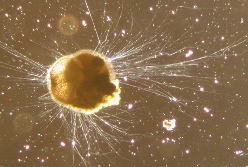
The Earth’s oceans are on their biggest acid trip for 55 million years. Ian Randall reports.
Geoscientist Online 15 February 2010
The world’s oceans are acidifying at their fastest rate for 55 million years, scientists say, with unknown consequences for the most basic elements of the food chain, the plankton. Models devised by researchers from the University of Bristol, which compare present acidification rates with those from the Paleocene-Eocene Thermal Maximum (PETM), predict that continuing changes in deep ocean chemistry could lead to a widespread extinction among carbonate-shelled benthic species, with possibly severe consequences for all ocean life. The research also suggests that the current decrease in ocean pH may also have a profound environmental impact on surface waters – resulting in rapid changes for which planktic forams are ill-equipped.
The acidification is being driven by an increase in carbon dioxide concentrations in the atmosphere - the ocean currently absorbs around one quarter of all CO
2 released into the Earth’s atmosphere. The Bristol researchers used an Earth system computer model called GENIE-1, but in a way that differed from past studies (which tended to be species specific). Instead, the researchers turned to the geological record to analyse the response of the marine ecosystem generally to increasing ocean acidity.
The study took the PETM, a sudden and extreme global warming event that occurred at the Paleocene-Eocene boundary over 55 million years ago, as the basis for their comparison. During this excursion, surface ocean temperatures rose by 5-6
oC over a period of a few thousand years, as a result of a massive (and largely unexplained) release of carbon into the atmosphere. The event was chosen because of its relative brevity: only rapid geological CO
2 releases (acting on timescales of less than 10,000 years) are able to overtake the natural regulation of carbonate saturation, and so have a major effect on marine life.
“Various types of geological evidence – the spread of warm water organisms towards the poles and the dissolution of carbonate sediments on the sea-floor tell us there was simultaneously both extreme warming and acidification at this time – the hallmark of a massive greenhouse gas release” says co-author, Dr Daniela Schmidt.
While no evidence of disaster is seen among surface-dwelling species, benthic organisms underwent a significant extinction event. Rising levels of acidity affected the carbonate saturation of the ocean, affecting in turn the ability of marine life to manufacture shells and skeletons from calcium carbonate. Such drastic, sudden pH changes can thus have devastating effects - resulting in the dissolution of carbonate shells and reduced growth rates, dwarfism and muscle atrophy in higher marine organisms.
The compared rates of past and future environmental change hint at an equal, or even greater, potential for such extinction levels resulting in the future.
“The widespread extinction of these ocean floor organisms during the Paleocene-Eocene greenhouse warming and acidification event tells us that similar extinctions in the future are possible” explains lead author, Dr Andy Ridgwell. “Unlike surface plankton, dwelling in a variable habitat, organisms living deep down on the ocean floor are adapted to much more stable conditions. A rapid and severe geochemical change in their environment would make their survival precarious.”
Reference
- Past constraints on the vulnerability of marine calcifiers to massive carbon dioxide release Andy Ridgwell and Daniela N. Schmidt Nature Geoscience: 14 February 2010